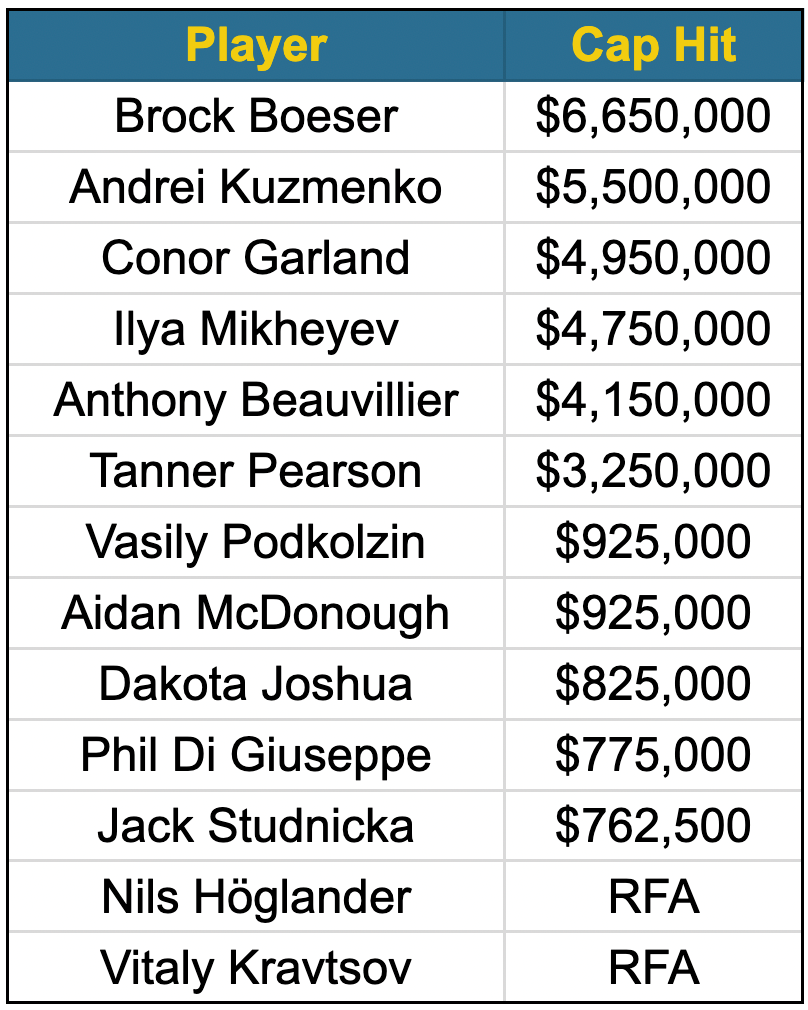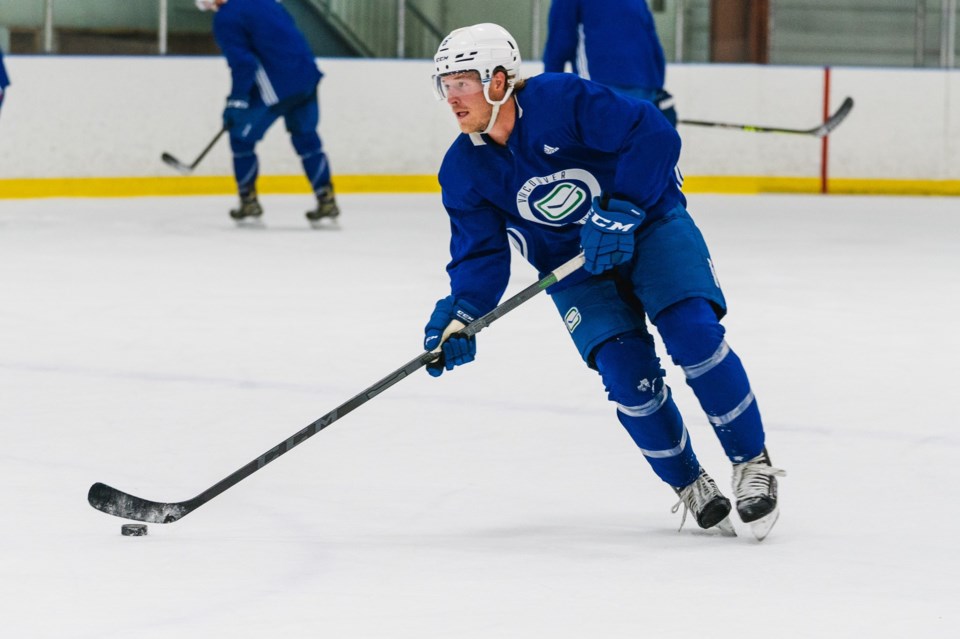The Vancouver Canucks have an excessive amount of wingers.
That’s what “plethora” means — “an excessive amount.” I would not want to be the type of person who told you the Canucks have a “plethora” and then have you find out that I have no idea what a “plethora” is.
It’s not just that the Canucks have a plethora of wingers, of course. The trouble is the Canucks have an excess number of expensive wingers. It’s not just a logjam on the wings but a logjam in the middle of their salary cap picture, forcing their Swedish general manager, Patrik Allvin, to do a very Canadian Log Driver’s Waltz to navigate it.
Inefficient spending on the wings
The Canucks have five wingers with a cap hit over $4 million. The Vegas Golden Knights and Florida Panthers, set to face off in the Stanley Cup Final, have three wingers each making over $4 million. Sure, that includes a $9.5 million winger each in Mark Stone and Matthew Tkachuk, but they’re also two of the best players in the NHL.
The trend around the NHL is to invest money at centre and on defence while looking for bargains on the wings.
All that is to say that the Canucks suffer from some inefficient spending. They have five wingers getting paid like top-six forwards, with only four of them actually able to play as top-six forwards at any given time: Brock Boeser, Andrei Kuzmenko, Conor Garland, Ilya Mikheyev, and Anthony Beauvillier.

Then there are a couple of significantly cheaper wingers looking to crack the team’s top-six but finding their path obstructed — Nils Höglander and Vasily Podkolzin — and a couple of bottom-six wingers who could find their way into a top-six role because of the predilections of head coach Rick Tocchet — Dakota Joshua and Phil Di Giuseppe.
That’s just the wingers that actually played games for the Canucks last season, so it doesn’t include young wingers like Danila Klimovich and Arshdeep Bains that could make a push next season or centres like Linus Karlsson and Aatu Räty that may end up as wingers at the NHL level.
That’s not to mention Tanner Pearson, whose career is in question but is still aiming to return next season.
“I’m still going to approach this summer like I’m still a hockey player,” said Pearson. “I have to, right?”
That’s at least nine wingers, not including Pearson, vying for four spots in the Canucks’ top six.
Not enough centres to go around
On the one hand, that kind of competition sounds great and gives the Canucks very strong depth on the wings.
On the other hand, that’s a lot of money tied up on wingers that will, by necessity, have to play in the team’s bottom six. That’s particularly troubling when the Canucks lack a third-line centre for those wingers to play with.
After trading away Bo Horvat last season, the Canucks have just two bonafide NHL-caliber centres: Elias Pettersson and J.T. Miller.
After that, the Canucks have Nils Åman, who has the potential to be a bottom-six centre in the NHL but had dreadful underlying numbers last season, Sheldon Dries, a replacement-level forward that probably should be in the AHL, Aatu Räty, who might end up on the wing at the NHL level, and a handful of other prospects with limited upside.
To top it all off, the Canucks’ second-line centre is arguably better on the wing. The Canucks will obviously keep Miller at centre — they have no choice — but it speaks to just how shallow their depth is down the middle that the Canucks literally have no one who could centre Miller even if they wanted to play him on the wing.
So, the Canucks have too many wingers and not enough centres. What can the Canucks do about it?
Trade a winger for a centre
Moving an expensive winger would clear cap space and open up a roster spot for a younger player, killing two birds with one stone. It’s possible they could kill a third bird with that exact same stone and trade a winger for a centre.
The Canucks just re-signed Kuzmenko and see him as a key piece of the first line with Pettersson, so he’s not getting moved. Mikheyev is recovering from knee surgery, so would be a tough sell on the trade market, and is also part of the Canucks’ Russian contingent with Kuzmenko and Podkolzin, so he’s unlikely to move as well.
But that leaves Boeser, Garland, and Beauvillier as potential trade options to move for a centre. The trouble is that centre is considered a more valuable position than wing, so winning a trade of that nature would be very difficult. The odds of getting a player better than Boeser, Garland, or Beauvillier would be low, but maybe that shouldn’t matter.
Trade a winger; acquire a centre separately
Maybe killing multiple birds with one stone isn’t the play. The Canucks could trade one of their expensive wingers for a defenceman instead or for draft picks and prospects. They could then acquire a centre in a separate deal.
That could mean signing a centre in free agency with the newly-cleared cap space. That could mean using the draft picks/prospects acquired in the winger trade to get a centre, the way they traded for Filip Hronek using the pick acquired in the Horvat trade.
All that is to say, don’t let perfect be the enemy of good — if a perfect trade isn’t available that gets the Canucks a much-needed centre for a winger, they could still make a couple of good trades that accomplish the same result.
Don’t trade a winger, sign a centre
The Canucks don’t have to trade a winger to clear cap space. They could conceivably find a way to dump salary in some other way, such as finding a way to trade Tyler Myers or some sort of shocking Miller trade at the eleventh hour.
If the Canucks can clear cap space in that way, they could look to free agency to fill their hole at centre — doubly so if they move Miller.
Trade no one, sign a centre
The Canucks don’t have cap space but there’s a chance the NHL’s salary cap could increase significantly — as much as $4 million. If it does, the Canucks might not have to trade anyone in order to afford a third-line centre in free agency.
It would leave them very little money to make improvements anywhere else in the lineup but, as Rick Tocchet is fond of saying, you eat an elephant one bite at a time.
Move a winger to centre
Instead of trading a winger for a centre, what if one of their wingers has secretly been a centre all along?
Okay, that seems unlikely, but maybe not completely outlandish. Beauvillier used to play centre in junior and has called centre his preferred position in the past. $4.15 million is a lot to pay for a third-line winger; it’s a much more palatable price for a third-line centre.
Joshua has also been a centre in the NHL before, albeit on the fourth line. Tocchet likes him as a north-south winger that can move up and down the lineup but what if his true home is in the middle of the third line?
Promote from within
The Canucks have terrible depth at centre in their prospect pool but maybe someone can be a third-line centre on the cheap. Räty is the obvious option, but Linus Karlsson has potential, even if he primarily played on the wing this past season.
Then there's Max Sasson, who the Canucks signed out of the NCAA this year. He's got some size, speed, and a detailed defensive game that might translate to the NHL. He'll already be 23 at the start of next season, so it wouldn't be like throwing a fresh-faced kid to the wolves. Just a thought.




